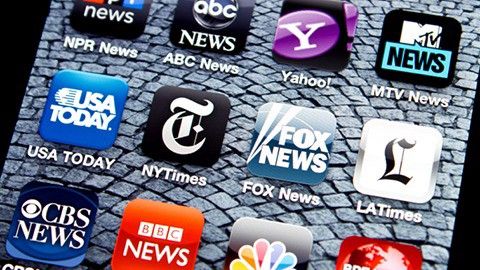More ads, AR and meditation await us – AppAnnie report
Applications – we own more and more of them, we spend more and more on them. Such conclusions are provided by the latest document „State of Mobile 2022” compiled by AppAnnie platform. What is the state of mobile technology in 2022?
Mobile First!
There are more and more indications that the saying mobile first will be on the lips of even more players than it is now. Mobile is eating up an ever-increasing slice of the technology pie, led of course by applications. According to AppAnnie’s calculations, taking into account the 10 largest markets, the weighted average exceeded 4 hours 48 minutes in 2021., Which is an increase of almost 30 percent. compared to two years earlier. In 2021, users in countries such as Brazil, Indonesia and South Korea have already exceeded 5 hours in terms of daily mobile apps. Americans spent an hour in apps longer than they spent watching TV, on average 3.1 hours. a day.
The results show a global estimate of 230 billion downloads, which generated 170 billion in information spending, resulting in 3.8 billion hours spent in mobile apps. Relative to the time spent in mobile last year, we can compare this to over 430,000 years! In the United States, mobile spending has skyrocketed, adding an additional $43 billion in 2021., which shows an increase of $10.4 billion, or 30 percent. more compared to 2020.
Mobile gaming and in-app subscriptions are becoming more common. For the Indian market, this was particularly evident, as it remains the largest of the emerging markets. For emerging markets, y/y downloads increased sequentially for: Pakistan by 25 percent., Peru by 25 percent., for the Philippines by 25 percent., for Vietnam by 20 percent., for Indonesia by 15 percent. and Egypt by 15 poc. increase in downloads than the year before.
Social still on top!
The report also shows that 70 percent of. time spent on a mobile device was consumed by social and photo apps. The paper also reports that there has been an increase in the share of time spent directly publishing photo and video content on sites such as TikTok and YouTube. Analysts have noticed a trend of directly engaging more and more with social media apps, without affecting each other. So far, the increases have come at the expense of declines from other app developers. This year, it was noted that as we age on mobile devices, we are not at all diminishing our life resources in them, leaving old habits behind and building new ones for ourselves. This means that we are spending more and more time in both the same apps and these new categories. In addition, consumers are engaging even more deeply in categories such as social, communication and photo/video apps.
21 million apps!
AppAnnie says two million new apps and games in 2021. Adding up this number with the output of all previous years, we get a figure of 21 million apps and games ever released on the AppStore and Google Play. Last year, the Apple store accounted for only 23 percent. app market.Despite Google Play’s lead over the AppStore in terms of the number of apps released yes the distribution of each category seems to be very similar for both players. On iOS and Android, games accounted for 15 percent. of all new launches in 2021. The remaining 85 percent. app start-ups include all categories directly related to mobile devices, such as social media, as well as categories that try to rely on mobile, such as insurance and healthcare.
The research also shows that more and more apps are also being removed and withdrawn from stores to leave the current broadcast, at 1.8 million on iOS and 3.6 million on Google Play.
In 2021. there were more than 233 apps and games exceeding $100 million annually in terms of consumer spending, with as many as 13 of them crossing over $1 billion. The year 2020 was full of 193 such apps, which equates to 20% of. y/y growth in terms of apps generating more than $100 million per year, and for those generating more than $1 billion, they grew by 5 over the last year. Researchers conclude that the rise in connectivity, screens and harware enhancements is followed by a greater willingness to use premium services, which undoubtedly increase the earnings of a given platform.
Millenials – wallets, and GenZ – communities
It’s hardly a revelation that the generation that was born into the tech boom will feel very comfortable with it. AppAnnie analysts indicate that generation Z is equivalent to a cell phone. Social media and apps related to photography and video recording are the most popular. Generation Z can be great for building engagement and developing a social network, and the purchases that go along with it. However, other types of apps are no longer entering the tastes of the younger generation. This is not the case with millenials, who have taken a liking to apps in the Finance and Shopping category. App Annie concludes that even if GenZ isn’t currently interested in investing in other categories, that doesn’t mean it’s not already worth building a proper launching pad for future investments in this area.
Market and gender differences
The study also indicates that when it comes to sports-related apps, regardless of market, there was a preponderance of male usage.Just as the apps found in the food and beverage categories are more used by women. While differences in Western markets may not be so pronounced in this context, it is evident in markets that have more established social norms related to culture and traditions, such as Japan. Japan.
What’s more, individual categories may give an advantage to one gender, but a particular app in a category in different markets will have a very different ratio than the general guidelines would indicate.
For example, apps in the shopping-related segment tend to interest more women than men, but Amazon app users behave quite differently. Men in Japan, the U.K., Germany, France and Canada use Bezos’ store significantly more than women. Only American women are ahead of US male representatives in this respect.
2022 full of advertising!
In 2021, the mobile ad market grew by a supercharged $295 billion, which turned out to be a 23 percent increase. on a yearly basis. Researchers also indicate that the mobile ad market could grow to $350 billion by 2022.
Analysts predict that the Beijing Olympics and U.S. elections will drive a surge in digital ad spending in 2022, with most of that spending going to mobile devices. Brands will focus even more on marketing, content, and targeting, which will grow as more people own phones and the devices themselves become more powerful.
AR is getting closer!
Analysts’ speculations also touch upon the experience in the field of social applications, within which the importance of AR technology is expected to grow. Mobile reality is changing along with the way we function. Augmented reality, due to the increasing vibrancy of the technology and the purchases associated with it, is increasingly viable to spread across the board. Snapchat, for example, has already created more than 6 billion AR interactions. Analysts see an opportunity for the development of this technology in its core, which is mobile, which is growing every year, consuming more and more of our time, and eventually, tired of it, we will reach for augmented reality, which can be useful for both companies and consumers.
2021 the year of meditation!
The study also showed that apps for meditation saw almost 30 percent. growth in terms of consumer spending. The pandemic that has brought stress into our reality, in a form far more intense than ever before, has forced us to reflect and slow down. Internet users have found the sauce in meditation, for which m. In. Calm app, which remains consistently the most downloaded meditation app as of 2020. Headspace comes in second, followed by Mediatopia in third place.
App Annie convinces us of a vision of reality that we don’t need to be convinced of, as it is visible to the naked eye. We will spend more and more time in the digital world, which will force us to increase our spending in this area. What is important, many analysts predict the emergence of multiapplications or solutions more integrated with our everyday life and personalized to our individual needs. App Annie also concludes by mentioning that the team strongly hopes that in healthcare, more people will use smartphones, tablets and wearables for health management, diagnosis and treatment.





